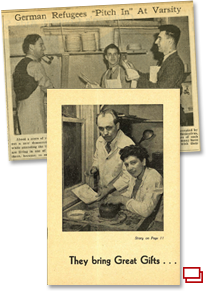Publicity
The release of growing numbers of internees into Canadian society was accompanied by a public relations campaign designed to stem any backlash against the refugees. Public opinion was turning in the internees’ favour. The logic of keeping men in custody whose sympathies lay with the Allies, and whose abilities were daily wasted, started to come under pointed criticism.
The Canadian government was anxious to control the stream of information about internment. In November 1941, Ottawa agreed to cooperate in two types of pro refugee publicity: “direct publicity” and “exhibitions.” All press releases from the Central Committee for Interned Refugees (CCIR) had to be approved by the Commissioner of Refugee Camps, Lieutenant-Colonel Fordham, and could only be sent to Canadian publications.
Once the release program was underway, the CCIR public relations efforts shifted to advocating permanent status. A campaign to allow refugees to become immigrants and to remain in Canada presented the internees’ stories from a human-interest angle, emphasizing stories of individual internees, their persecution in Europe and their experiences upon release in Canada. Few articles dealt with the internees as a group or with the number of jobs they occupied, in order to avoid the appearance of refugees posing a threat to Canadian labour.
 Dossier
Dossier
A collection of images relating to publicity.


